Fundamentals of Finance: Analyzing Risk, Return, and Portfolio Beta
VerifiedAdded on 2023/06/15
|10
|1443
|366
Homework Assignment
AI Summary
This assignment delves into the fundamentals of finance, focusing on expected return, risk analysis, and portfolio management. It explains the calculation and interpretation of expected returns using probability distributions, differentiating between risk-averse and risk-taking investors. The documen...

Running head: FUNDAMENTALS OF FINANCE
Fundamentals of Finance
Name of the Student:
Name of the University:
Author’s Note:
Course ID:
Fundamentals of Finance
Name of the Student:
Name of the University:
Author’s Note:
Course ID:
Paraphrase This Document
Need a fresh take? Get an instant paraphrase of this document with our AI Paraphraser
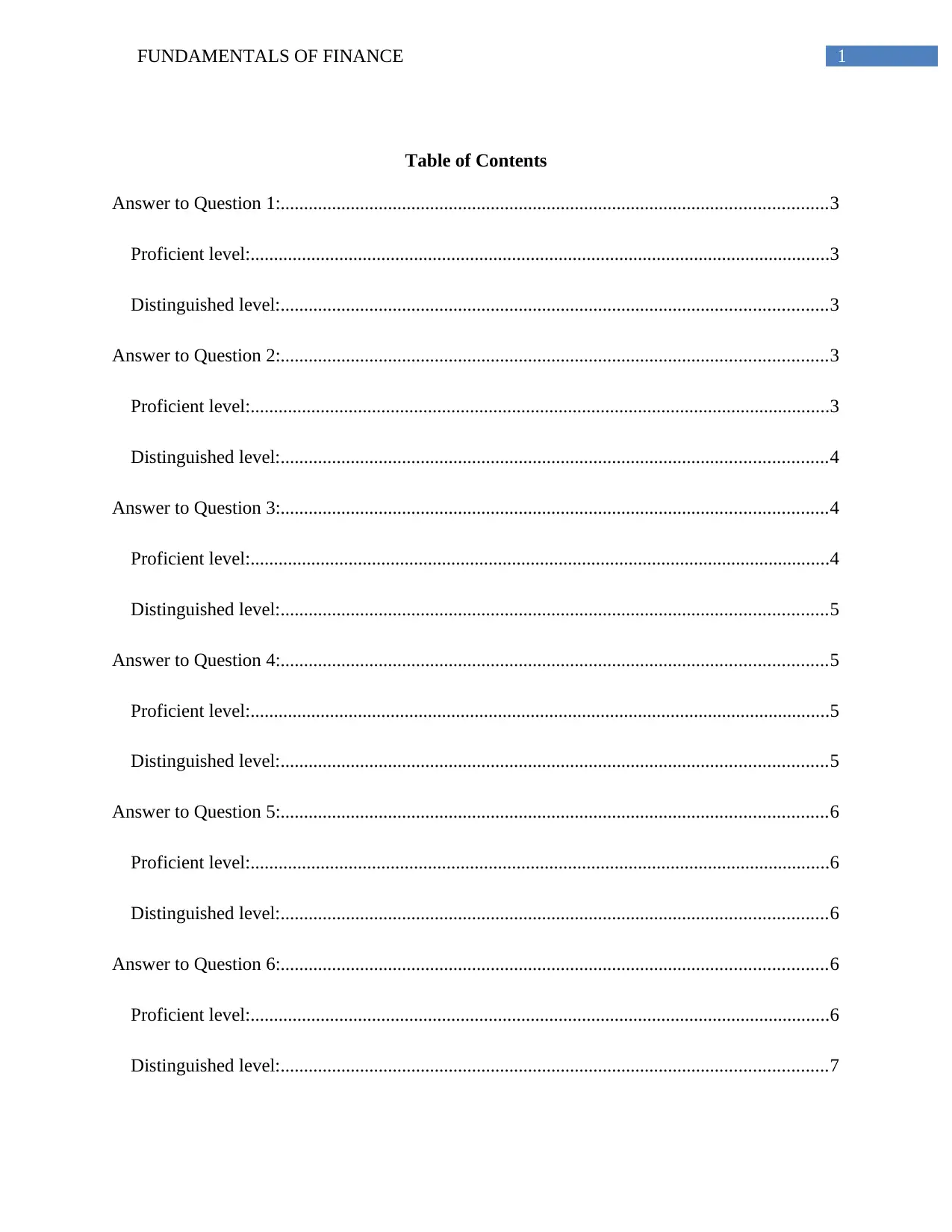
1FUNDAMENTALS OF FINANCE
Table of Contents
Answer to Question 1:.....................................................................................................................3
Proficient level:............................................................................................................................3
Distinguished level:.....................................................................................................................3
Answer to Question 2:.....................................................................................................................3
Proficient level:............................................................................................................................3
Distinguished level:.....................................................................................................................4
Answer to Question 3:.....................................................................................................................4
Proficient level:............................................................................................................................4
Distinguished level:.....................................................................................................................5
Answer to Question 4:.....................................................................................................................5
Proficient level:............................................................................................................................5
Distinguished level:.....................................................................................................................5
Answer to Question 5:.....................................................................................................................6
Proficient level:............................................................................................................................6
Distinguished level:.....................................................................................................................6
Answer to Question 6:.....................................................................................................................6
Proficient level:............................................................................................................................6
Distinguished level:.....................................................................................................................7
Table of Contents
Answer to Question 1:.....................................................................................................................3
Proficient level:............................................................................................................................3
Distinguished level:.....................................................................................................................3
Answer to Question 2:.....................................................................................................................3
Proficient level:............................................................................................................................3
Distinguished level:.....................................................................................................................4
Answer to Question 3:.....................................................................................................................4
Proficient level:............................................................................................................................4
Distinguished level:.....................................................................................................................5
Answer to Question 4:.....................................................................................................................5
Proficient level:............................................................................................................................5
Distinguished level:.....................................................................................................................5
Answer to Question 5:.....................................................................................................................6
Proficient level:............................................................................................................................6
Distinguished level:.....................................................................................................................6
Answer to Question 6:.....................................................................................................................6
Proficient level:............................................................................................................................6
Distinguished level:.....................................................................................................................7

2FUNDAMENTALS OF FINANCE
Answer to Question 7:.....................................................................................................................7
Proficient level:............................................................................................................................7
Distinguished level:.....................................................................................................................8
References:......................................................................................................................................9
Answer to Question 7:.....................................................................................................................7
Proficient level:............................................................................................................................7
Distinguished level:.....................................................................................................................8
References:......................................................................................................................................9
You're viewing a preview
Unlock full access by subscribing today!
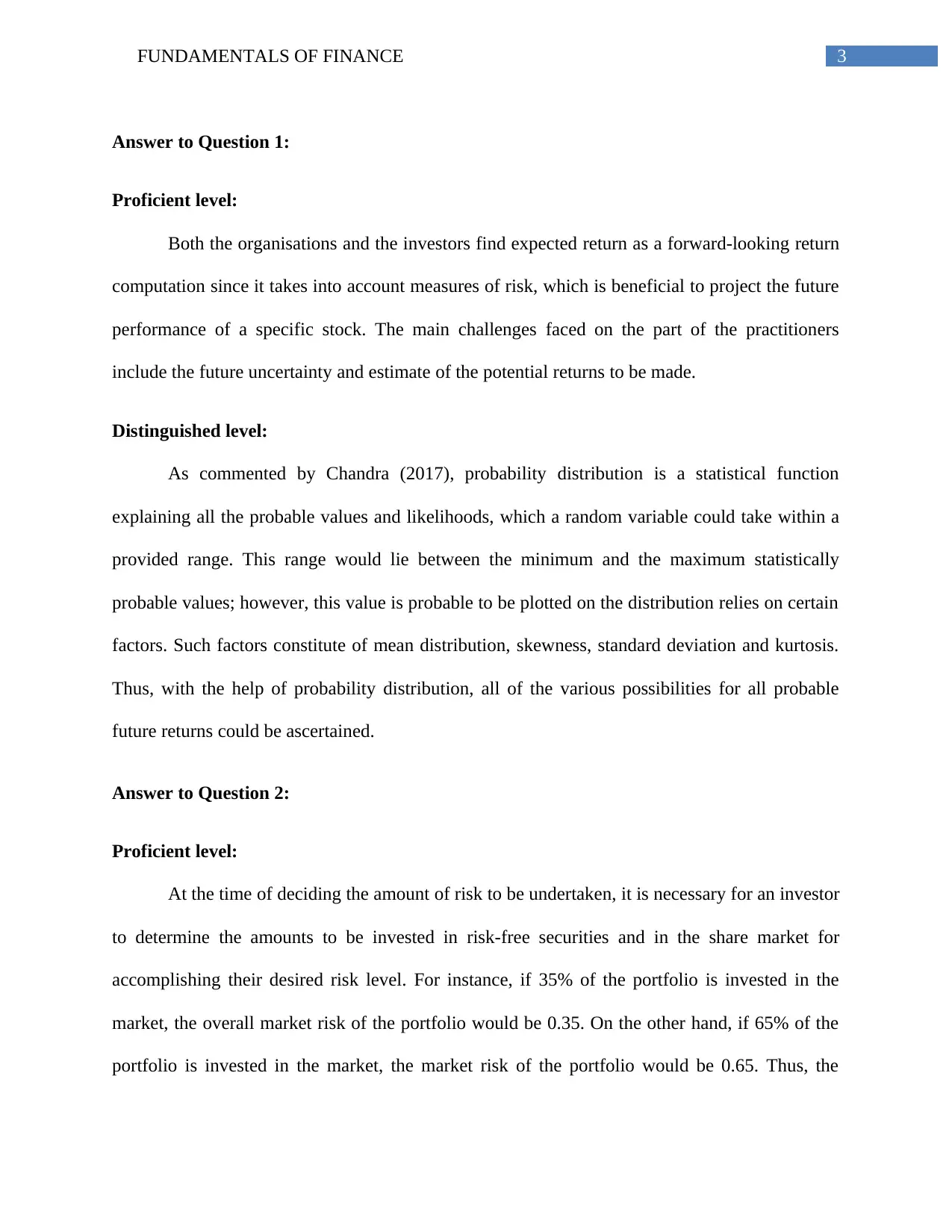
3FUNDAMENTALS OF FINANCE
Answer to Question 1:
Proficient level:
Both the organisations and the investors find expected return as a forward-looking return
computation since it takes into account measures of risk, which is beneficial to project the future
performance of a specific stock. The main challenges faced on the part of the practitioners
include the future uncertainty and estimate of the potential returns to be made.
Distinguished level:
As commented by Chandra (2017), probability distribution is a statistical function
explaining all the probable values and likelihoods, which a random variable could take within a
provided range. This range would lie between the minimum and the maximum statistically
probable values; however, this value is probable to be plotted on the distribution relies on certain
factors. Such factors constitute of mean distribution, skewness, standard deviation and kurtosis.
Thus, with the help of probability distribution, all of the various possibilities for all probable
future returns could be ascertained.
Answer to Question 2:
Proficient level:
At the time of deciding the amount of risk to be undertaken, it is necessary for an investor
to determine the amounts to be invested in risk-free securities and in the share market for
accomplishing their desired risk level. For instance, if 35% of the portfolio is invested in the
market, the overall market risk of the portfolio would be 0.35. On the other hand, if 65% of the
portfolio is invested in the market, the market risk of the portfolio would be 0.65. Thus, the
Answer to Question 1:
Proficient level:
Both the organisations and the investors find expected return as a forward-looking return
computation since it takes into account measures of risk, which is beneficial to project the future
performance of a specific stock. The main challenges faced on the part of the practitioners
include the future uncertainty and estimate of the potential returns to be made.
Distinguished level:
As commented by Chandra (2017), probability distribution is a statistical function
explaining all the probable values and likelihoods, which a random variable could take within a
provided range. This range would lie between the minimum and the maximum statistically
probable values; however, this value is probable to be plotted on the distribution relies on certain
factors. Such factors constitute of mean distribution, skewness, standard deviation and kurtosis.
Thus, with the help of probability distribution, all of the various possibilities for all probable
future returns could be ascertained.
Answer to Question 2:
Proficient level:
At the time of deciding the amount of risk to be undertaken, it is necessary for an investor
to determine the amounts to be invested in risk-free securities and in the share market for
accomplishing their desired risk level. For instance, if 35% of the portfolio is invested in the
market, the overall market risk of the portfolio would be 0.35. On the other hand, if 65% of the
portfolio is invested in the market, the market risk of the portfolio would be 0.65. Thus, the
Paraphrase This Document
Need a fresh take? Get an instant paraphrase of this document with our AI Paraphraser

4FUNDAMENTALS OF FINANCE
distribution of investment between 0% - 100% in a market portfolio could provide the investor
with an alternative to select any market level risk they want.
Distinguished level:
In the words of HA Davis & Lleo (2015), the marginal utility of income of a risk-averse
investor is declining and a particular income is desired over a gamble with the identical possible
income. On the contrary, the marginal utility of income in case of a risk-taker is increasing by
selecting uncertain income to certain income. Considering the above stated example, if an
investor decides to invest 35% of the portfolio, Beta for the same would be 0 .35, which denotes
greater risk. Such investors are termed as risk-averse investors. On the other hand, if 65% of the
portfolio is invested in the market, Beta would be 0.65 and this denotes lower risk. Such
investors would be considered as risk-takers.
Answer to Question 3:
Proficient level:
In order to calculate the expected return, the sum of each return is to be multiplied with
the probability of each return and then they are added together. In this case, the economic state of
fast growth would provide return of 40% having probability of 0.25. On the other hand, the slow
growth economy would fetch return of 10% and this would have probability of 0.5. During
economic recession, there would be return of -4% having probability of 0.25.
Expected return = (0.25 x 40%) + (0.50 x 10%) + (0.25 x -4%)
Expected return = 0.10 + 0.05 - 0.01
Expected return = 0.14 = 14%
distribution of investment between 0% - 100% in a market portfolio could provide the investor
with an alternative to select any market level risk they want.
Distinguished level:
In the words of HA Davis & Lleo (2015), the marginal utility of income of a risk-averse
investor is declining and a particular income is desired over a gamble with the identical possible
income. On the contrary, the marginal utility of income in case of a risk-taker is increasing by
selecting uncertain income to certain income. Considering the above stated example, if an
investor decides to invest 35% of the portfolio, Beta for the same would be 0 .35, which denotes
greater risk. Such investors are termed as risk-averse investors. On the other hand, if 65% of the
portfolio is invested in the market, Beta would be 0.65 and this denotes lower risk. Such
investors would be considered as risk-takers.
Answer to Question 3:
Proficient level:
In order to calculate the expected return, the sum of each return is to be multiplied with
the probability of each return and then they are added together. In this case, the economic state of
fast growth would provide return of 40% having probability of 0.25. On the other hand, the slow
growth economy would fetch return of 10% and this would have probability of 0.5. During
economic recession, there would be return of -4% having probability of 0.25.
Expected return = (0.25 x 40%) + (0.50 x 10%) + (0.25 x -4%)
Expected return = 0.10 + 0.05 - 0.01
Expected return = 0.14 = 14%
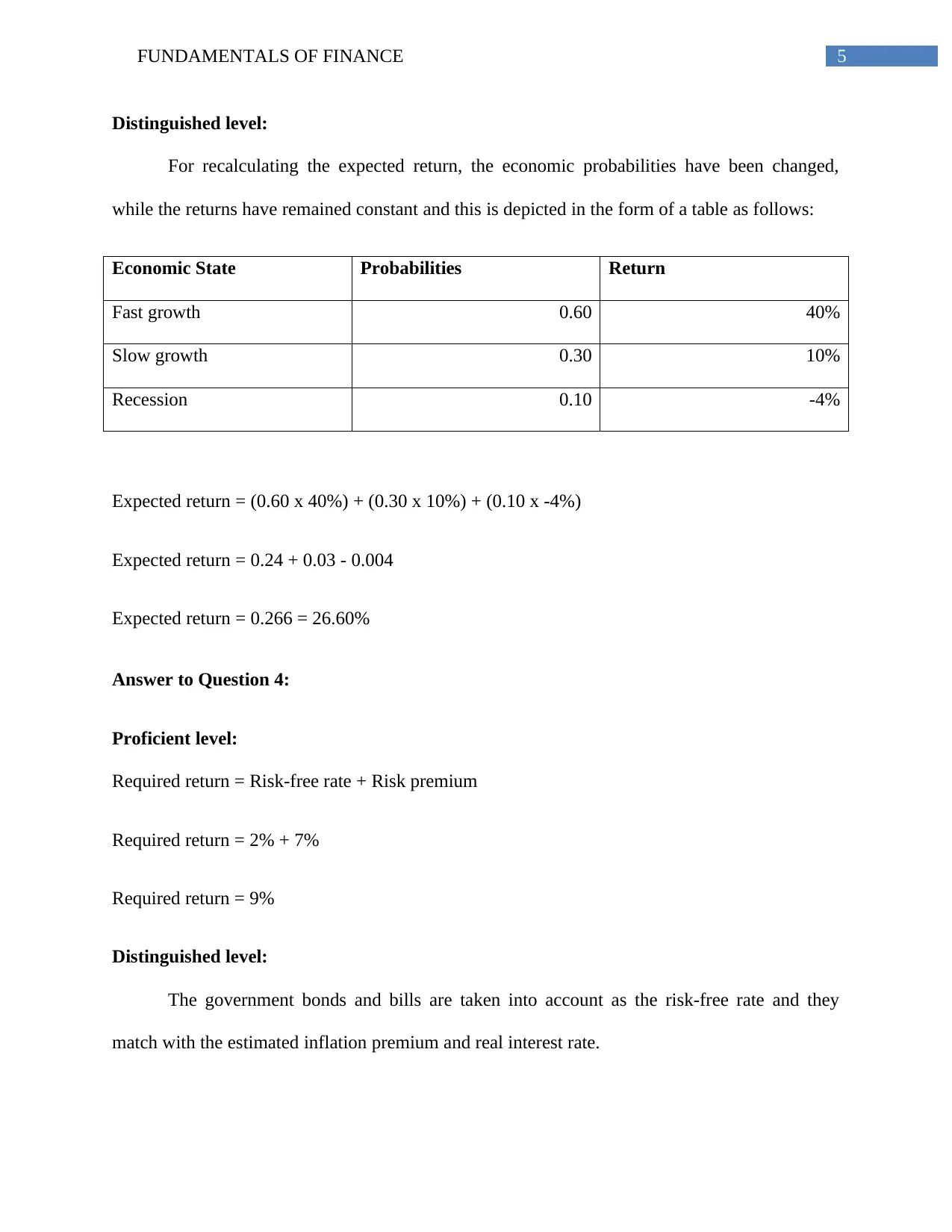
5FUNDAMENTALS OF FINANCE
Distinguished level:
For recalculating the expected return, the economic probabilities have been changed,
while the returns have remained constant and this is depicted in the form of a table as follows:
Economic State Probabilities Return
Fast growth 0.60 40%
Slow growth 0.30 10%
Recession 0.10 -4%
Expected return = (0.60 x 40%) + (0.30 x 10%) + (0.10 x -4%)
Expected return = 0.24 + 0.03 - 0.004
Expected return = 0.266 = 26.60%
Answer to Question 4:
Proficient level:
Required return = Risk-free rate + Risk premium
Required return = 2% + 7%
Required return = 9%
Distinguished level:
The government bonds and bills are taken into account as the risk-free rate and they
match with the estimated inflation premium and real interest rate.
Distinguished level:
For recalculating the expected return, the economic probabilities have been changed,
while the returns have remained constant and this is depicted in the form of a table as follows:
Economic State Probabilities Return
Fast growth 0.60 40%
Slow growth 0.30 10%
Recession 0.10 -4%
Expected return = (0.60 x 40%) + (0.30 x 10%) + (0.10 x -4%)
Expected return = 0.24 + 0.03 - 0.004
Expected return = 0.266 = 26.60%
Answer to Question 4:
Proficient level:
Required return = Risk-free rate + Risk premium
Required return = 2% + 7%
Required return = 9%
Distinguished level:
The government bonds and bills are taken into account as the risk-free rate and they
match with the estimated inflation premium and real interest rate.
You're viewing a preview
Unlock full access by subscribing today!
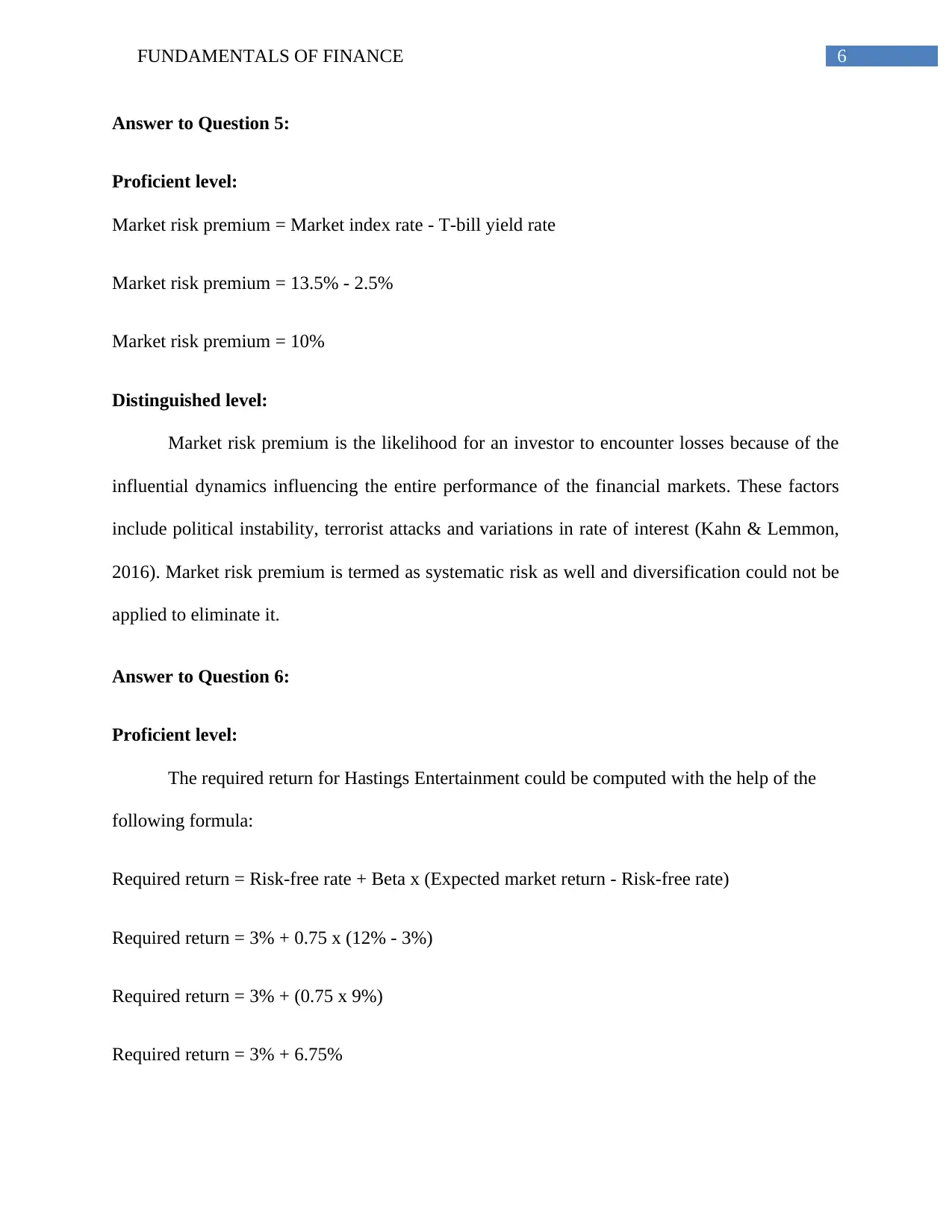
6FUNDAMENTALS OF FINANCE
Answer to Question 5:
Proficient level:
Market risk premium = Market index rate - T-bill yield rate
Market risk premium = 13.5% - 2.5%
Market risk premium = 10%
Distinguished level:
Market risk premium is the likelihood for an investor to encounter losses because of the
influential dynamics influencing the entire performance of the financial markets. These factors
include political instability, terrorist attacks and variations in rate of interest (Kahn & Lemmon,
2016). Market risk premium is termed as systematic risk as well and diversification could not be
applied to eliminate it.
Answer to Question 6:
Proficient level:
The required return for Hastings Entertainment could be computed with the help of the
following formula:
Required return = Risk-free rate + Beta x (Expected market return - Risk-free rate)
Required return = 3% + 0.75 x (12% - 3%)
Required return = 3% + (0.75 x 9%)
Required return = 3% + 6.75%
Answer to Question 5:
Proficient level:
Market risk premium = Market index rate - T-bill yield rate
Market risk premium = 13.5% - 2.5%
Market risk premium = 10%
Distinguished level:
Market risk premium is the likelihood for an investor to encounter losses because of the
influential dynamics influencing the entire performance of the financial markets. These factors
include political instability, terrorist attacks and variations in rate of interest (Kahn & Lemmon,
2016). Market risk premium is termed as systematic risk as well and diversification could not be
applied to eliminate it.
Answer to Question 6:
Proficient level:
The required return for Hastings Entertainment could be computed with the help of the
following formula:
Required return = Risk-free rate + Beta x (Expected market return - Risk-free rate)
Required return = 3% + 0.75 x (12% - 3%)
Required return = 3% + (0.75 x 9%)
Required return = 3% + 6.75%
Paraphrase This Document
Need a fresh take? Get an instant paraphrase of this document with our AI Paraphraser
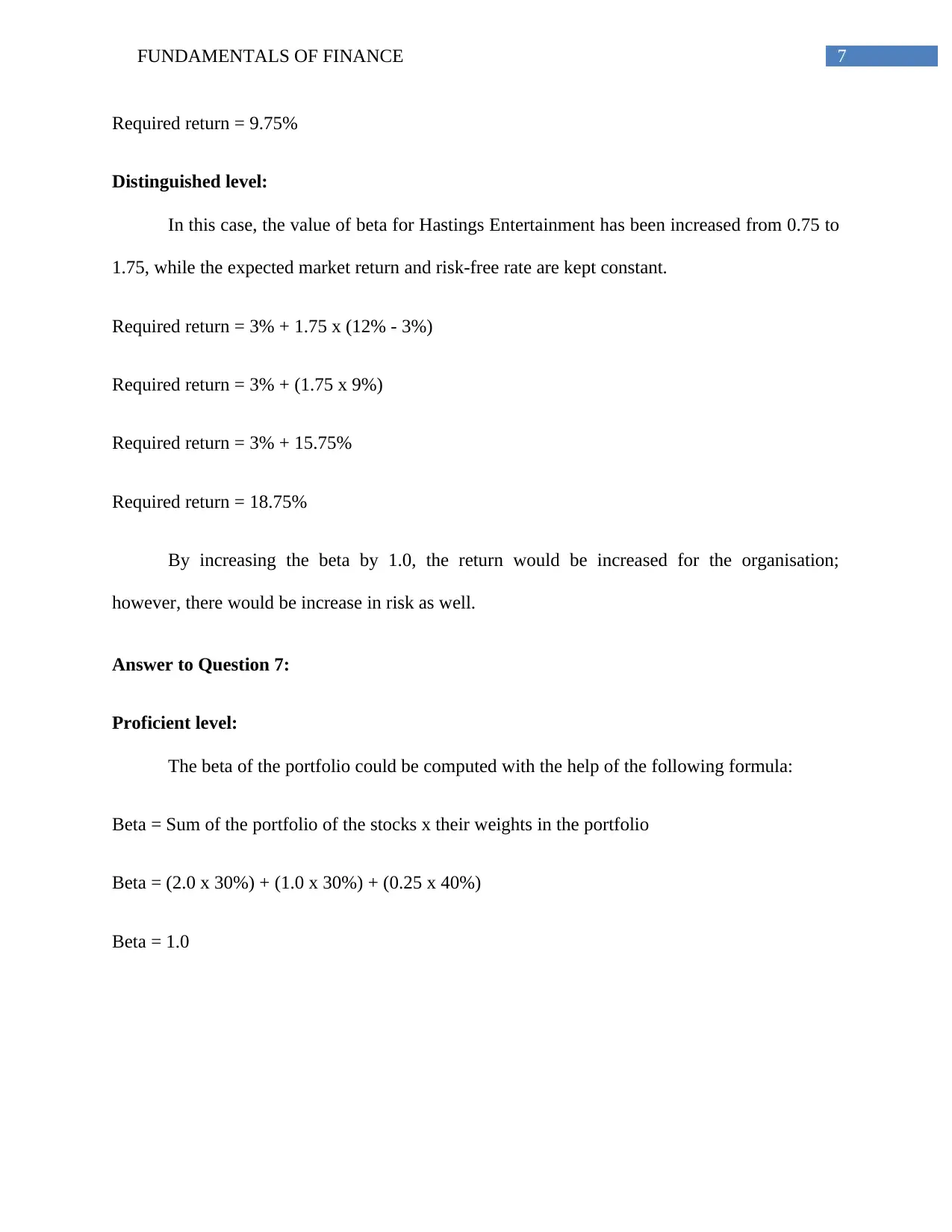
7FUNDAMENTALS OF FINANCE
Required return = 9.75%
Distinguished level:
In this case, the value of beta for Hastings Entertainment has been increased from 0.75 to
1.75, while the expected market return and risk-free rate are kept constant.
Required return = 3% + 1.75 x (12% - 3%)
Required return = 3% + (1.75 x 9%)
Required return = 3% + 15.75%
Required return = 18.75%
By increasing the beta by 1.0, the return would be increased for the organisation;
however, there would be increase in risk as well.
Answer to Question 7:
Proficient level:
The beta of the portfolio could be computed with the help of the following formula:
Beta = Sum of the portfolio of the stocks x their weights in the portfolio
Beta = (2.0 x 30%) + (1.0 x 30%) + (0.25 x 40%)
Beta = 1.0
Required return = 9.75%
Distinguished level:
In this case, the value of beta for Hastings Entertainment has been increased from 0.75 to
1.75, while the expected market return and risk-free rate are kept constant.
Required return = 3% + 1.75 x (12% - 3%)
Required return = 3% + (1.75 x 9%)
Required return = 3% + 15.75%
Required return = 18.75%
By increasing the beta by 1.0, the return would be increased for the organisation;
however, there would be increase in risk as well.
Answer to Question 7:
Proficient level:
The beta of the portfolio could be computed with the help of the following formula:
Beta = Sum of the portfolio of the stocks x their weights in the portfolio
Beta = (2.0 x 30%) + (1.0 x 30%) + (0.25 x 40%)
Beta = 1.0
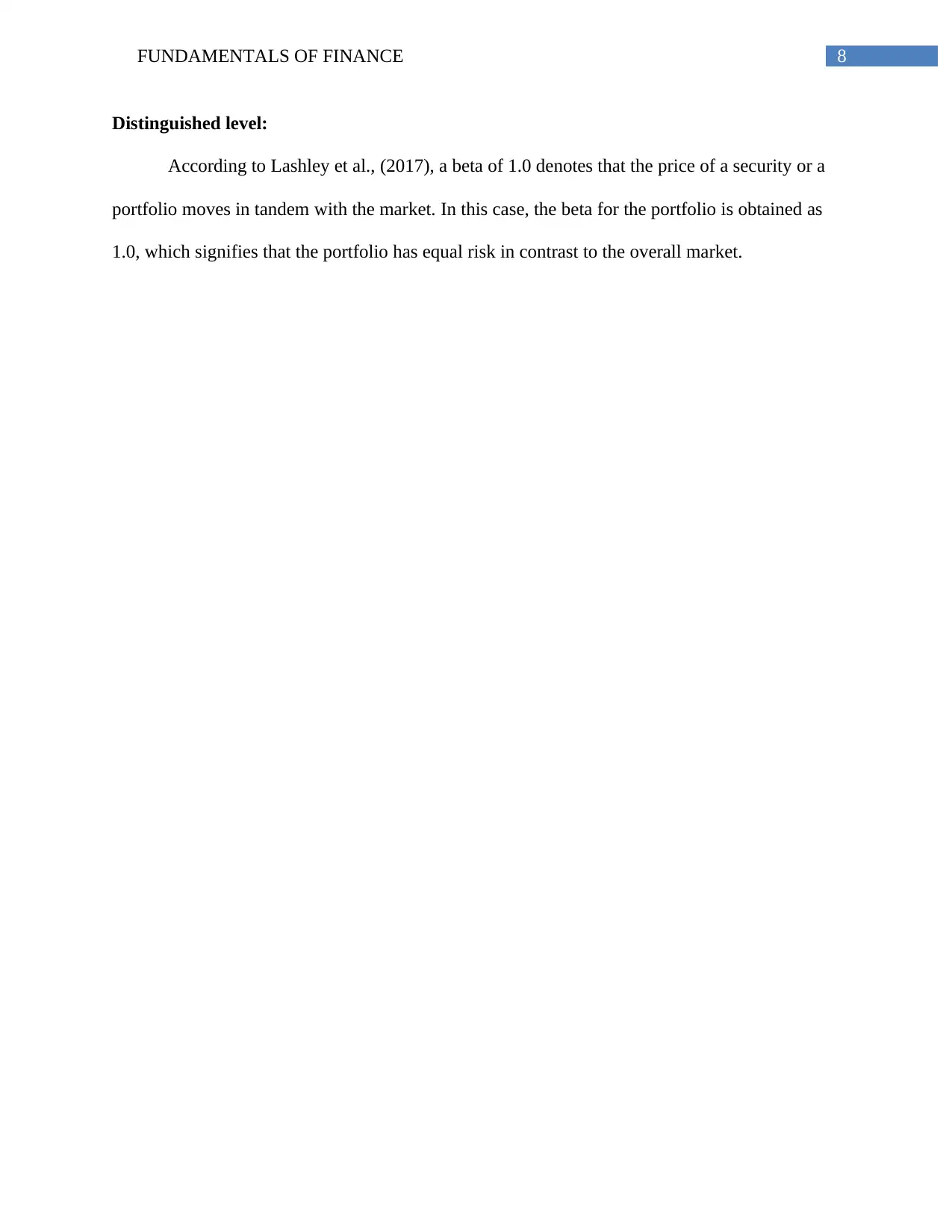
8FUNDAMENTALS OF FINANCE
Distinguished level:
According to Lashley et al., (2017), a beta of 1.0 denotes that the price of a security or a
portfolio moves in tandem with the market. In this case, the beta for the portfolio is obtained as
1.0, which signifies that the portfolio has equal risk in contrast to the overall market.
Distinguished level:
According to Lashley et al., (2017), a beta of 1.0 denotes that the price of a security or a
portfolio moves in tandem with the market. In this case, the beta for the portfolio is obtained as
1.0, which signifies that the portfolio has equal risk in contrast to the overall market.
You're viewing a preview
Unlock full access by subscribing today!

9FUNDAMENTALS OF FINANCE
References:
Chandra, P. (2017). Investment analysis and portfolio management. McGraw-Hill Education.
HA Davis, M., & Lleo, S. (2015). Risk-Sensitive Investment Management.
Kahn, R. N., & Lemmon, M. (2016). The asset manager’s dilemma: How smart beta is disrupting
the investment management industry. Financial Analysts Journal, 72(1), 15-20.
Lashley, G., Parker, G., Singh, S., Wise, J., & Polwitoon, P. (2017). Managing Your Investment
Portfolio: All Things ETF.
References:
Chandra, P. (2017). Investment analysis and portfolio management. McGraw-Hill Education.
HA Davis, M., & Lleo, S. (2015). Risk-Sensitive Investment Management.
Kahn, R. N., & Lemmon, M. (2016). The asset manager’s dilemma: How smart beta is disrupting
the investment management industry. Financial Analysts Journal, 72(1), 15-20.
Lashley, G., Parker, G., Singh, S., Wise, J., & Polwitoon, P. (2017). Managing Your Investment
Portfolio: All Things ETF.
1 out of 10
Related Documents
Your All-in-One AI-Powered Toolkit for Academic Success.
+13062052269
info@desklib.com
Available 24*7 on WhatsApp / Email
![[object Object]](/_next/static/media/star-bottom.7253800d.svg)
Unlock your academic potential
© 2024 | Zucol Services PVT LTD | All rights reserved.



